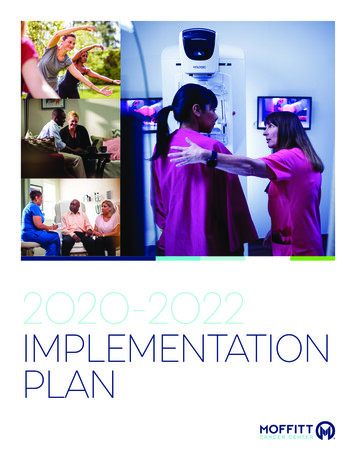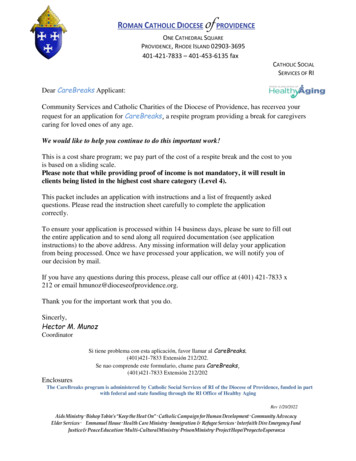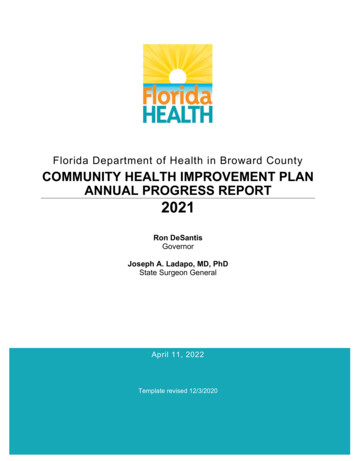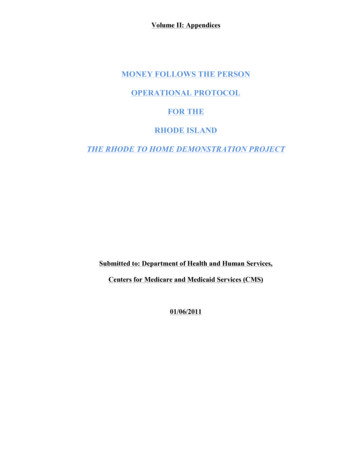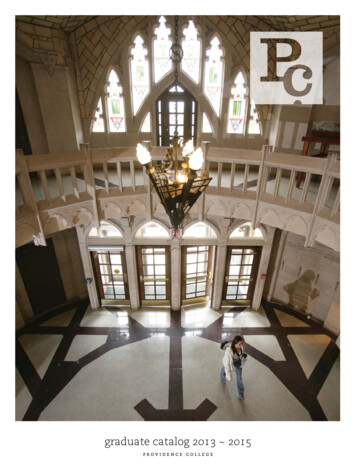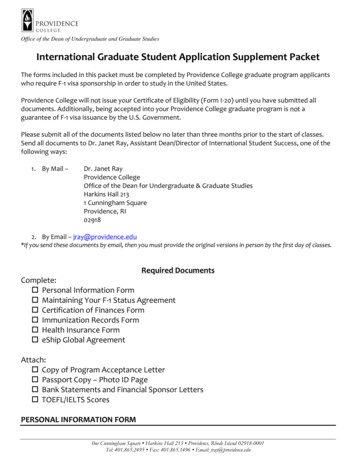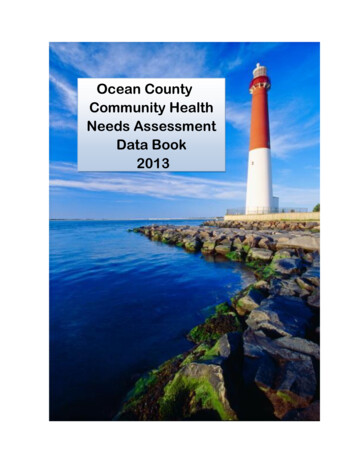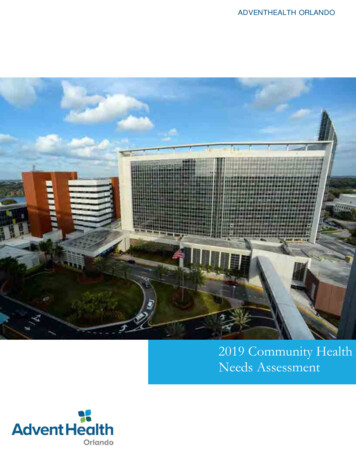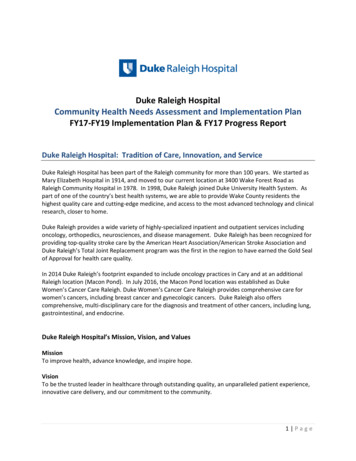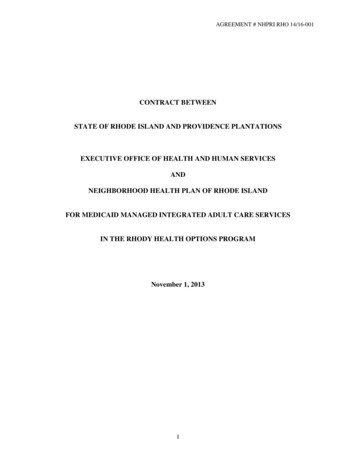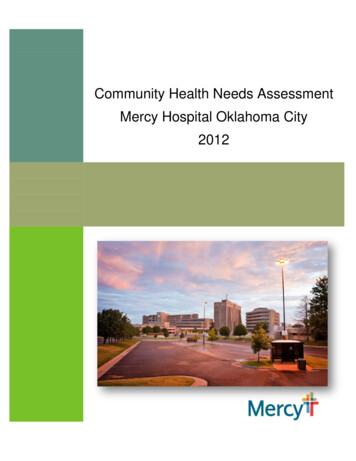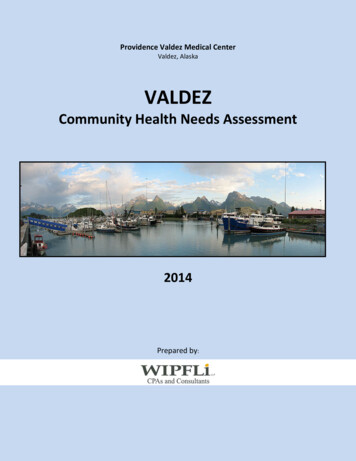
Transcription
0Providence Valdez Medical CenterValdez, AlaskaVALDEZCommunity Health Needs Assessment2014Prepared by:
1Table of ContentsIntroduction . 1Methods . 1CHNA Process . 2CHNA Advisory Committee . 3Community Served Determination. 7Data Collection and Analysis . 7Information Gaps . 8Summary of Key Findings . 9Summary of Prioritized Needs . 21Existing Health Care and other Facilities and Resources. 23Implementation Plan. 23References . 24Appendix 1 – List of Interviewees for Community Input . 25Appendix 2 – Demographic, Primary and Secondary Data . 27Appendix 3 – Community Health Survey . 39Appendix 4 – Community/Demographic Profile . 60Appendix 5 – Community Resource List. 77Appendix 6 – CHNA Executive Summary and Implementation Plan . 84
1IntroductionProvidence Valdez Medical Center (PVMC) is an 11 bed critical access hospital (CAH)that provides quality inpatient and outpatient health care to Valdez residents and visitorswith an array of local services. 24-hour Emergency Services11 acute care and 10 long-term care bedsObstetrical services, anesthesia, labor & delivery, post-partum careLaboratory - CLIA-certifiedImaging services to include ultrasound, CAT scan, and bone densitometryPhysical, Occupational and Speech TherapyStress testingGeneral medical careEndoscopy and minor surgical servicesSleep disorder studiesSpecialty Physician ClinicsOur team of physicians, nurses, and support staff deliver compassionate, quality care toall patients.MethodsWipfli’s RoleIn 2014, Wipfli LLP (Wipfli) was engaged by leadership at PVMC and Providence HealthServices Alaska to facilitate a community health needs assessment (CHNA) process onbehalf of the hospital. This CHNA report was completed in compliance with the IRSrequirements described in section 501(r)(3) of the Internal Revenue Code.
2CHNA ProcessThe CHNA process that Wipfli and Providence Health and Services Alaska (PHSA)utilized to conduct the assessment has been adopted from several of the leadingsources on the subject. These sources include: Association for Community Health Improvement,Flex Monitoring Team, andRural Health Works.The following outline explains the process that Wipfli and PHSA followed to conduct theCHNA. Each process is described in more detail throughout the report.1. Formation of a CHNA advisory committee2. Definition of the community served by PVMC3. Data collection and Analysisa. Demographics of the communityb. Primary data (community survey and key-stakeholder interviews)c. Secondary data/Demographicsd. Existing health care facilities and resources4. Identification and prioritization of community health needs and services to meetcommunity health needs5. Adoption of goals and implementation strategy to respond to prioritized needs incollaboration with community partners6. Dissemination of priorities and implementation strategy to the public
3CHNA Advisory CommitteeThe committee was tasked with completing key objectives outlined by the IRS CHNArequirements, including the identification of health issues and prioritized health needswithin the community. The committee consisted of the following members:Barbara Bigelow, Chief Administrative Officer, Providence Valdez Medical Center.PVMC provides comprehensive health care to residents and visitors of Valdez; PrinceWilliam Sound and Richardson Highway communities. As a critical access hospital(CAH), PVMC features 11 acute care and swing beds. PVMC delivers about 45 babiesannually and provides general acute care services, including emergency care;diagnostic lab; an imaging center, soon to include an MRI (end of 2014); a sleep center;and rehabilitation therapy (PT, OT & Speech) services. In addition PVMC provides 10extended care beds and a counseling center.Joshua Buffington, Administrative Coordinator, Valdez Fisheries DevelopmentAssociation, Inc. (Human Resources, Safety and Occupational Health, InformationTechnology, Permitting, Grants) Joshua currently holds positions with the Valdez LocalEmergency Planning Committee as Chair, PVMC HAC, and communications forEpiphany Church in Valdez. He has worked as a Paramedic in Emergency MedicalServices for 17 years, including holding the rank of Captain and Director of Operations.Formerly Joshua served as the Deputy Director for the State of Kansas ImmunizationProgram.John Cullen, MD, General Partner, Valdez Medical Clinic; Chief of Staff, PVMC; andmember of the PVMC Health Advisory Board. The Valdez Medical Clinic is a fullservice family practice clinic, consisting of four physicians, that includes coverage of thehospital’s emergency room. It is the only primary care clinic located in Valdez.Dave Dengel, CEO, Copper Valley Telecom, PVMC Health Advisory Council Member.Copper Valley Telecom is a telecommunications provider offering Wireline, Internet,Cellular, Long Distance and long haul fiber in the Valdez, Prince William Sound andCopper Basin.Pauline Doucet, Assistant Administrator-Director of Clinical Services, PVMC. Herresponsibilities include community outreach, physician engagement and day-to-daymanagement of clinical operations (Acute Care departments and Long Term Care- asLTC Administrator and Manager). She brings 30 years of clinical nursing experience toher role at PVMC.Marianne Freebury, PVMC Health Advisory Council Member. She is a registered nursewith over 30 years experience in hospital, long term care, home care/hospice, qualityimprovement, wellness and disease management, as well as in data analytical areas ofhealthcare.
4Joan Heikens, BSN. Care Coordinator, Valdez Senior Center and PVMC HealthAdvisory Council Member. She has worked in nursing since she was 16. She beganher work with seniors as an aid in a nursing home and continues her service to seniorsas a care coordinator at the Valdez Senior Center.Valencia (Val) Hiebert is a lifelong, Native Alaskan originally from Southeast AK andhas been residing in Valdez since 1987. She is a PVMC Health Advisory CouncilMember and her goals pertaining to health care are elder care and advocacy andfurther developing quality health care to rural communities. She has worked in the oilindustry in areas pertaining to automation and operations of oil production andtransportation.Ruth E. Knight, Teacher- Valdez City Schools, City Council member - City of Valdez,and PVMC Health Advisory Council Member. Valdez City Schools is a rural, publicschool district with one elementary school, one middle school, one high school, and onehome school program.Nancy Lethcoe, Retired tourism business owner and owner of Prince William SoundBooks, PVMC Health Advisory Council Member and a 25 year resident of Valdez. Hervolunteer work includes a Buddhist Paper Sangha for prisoners, the Valdez Food Bank,Epiphany Church Council, and the Providence Health Advisory Council.Jeremy O'Neil, CFO - PVMC, Director - Providence Valdez Counseling Center (PVCC).PVMC provides comprehensive health care to residents and visitors of Valdez; PrinceWilliam Sound and Richardson Highway communities. PVCC is the sole behavioralhealth service provider in Valdez offering a variety of services and is staffed by aPsychiatrist, Licensed Professional Counselors, a Licensed Clinical Social Worker,Certified Chemical Dependency Counselors, and a Case Manager.Cindy Rymer, Administration, City of Valdez Public Works Department and PVMCHealth Advisory Council Member. She is a 39 year resident of Valdez and has been apart of the Hospital in one way or the other as a member of the Hospital Task Force ,Hospital Auxiliary, as well as the Advisory board since 1999.Pam Shirrell, Registered Nurse (RN), Licensed Nursing Home Administrator, 25 yearresident of Valdez. 12 years acute care experience as an RN prior to moving to Valdez,6 years as Health Services Director, Harborview Developmental Center, and 17 yearsas the Valdez Public Health Nurse retiring in 2013. Currently: Chair, Providence ValdezHealth Advisory Board; Member, Providence Regional Ministry Board; Chair, PrinceWilliam Sound Community College; Member, Valdez Local Emergency PlanningCommittee; Co-Chair, Prince William Sound Traveling Health & Safety Fair.Todd Wegner, Assistant City Manager - City of Valdez, PVMC Health Advisory CouncilMember. The City of Valdez is responsible for a variety of public services, includingemergency services and public safety, community planning, public facilities and citylands, hazard mitigation and flood zone management, harbor management, snow and
5garbage removal, water and wastewater provision, parks and recreation, annualbudgeting, Valdez permanent fund management, and governance. HealthcareContinuum of Care has been a long-standing priority for the community of Valdez, as itstrives promote a superior healthcare system for its residents.Tina Fifarek, Former Board Chairperson of Sound Wellness Alliance Network (SWAN)and member since SWANS’ inception. Executive Assist/HR Specialist, City of Valdez13 years at COV Middle and High School Cheer Coach-entering 7th year coaching atHS level, 4th at MS level.Hope Finley, Sound Wellness Alliance Network (SWAN) Coordinator - PVMC. SWANwas established in 2009 to address needs identified in the 2008 Valdez CommunityHealth Needs Assessment. Its mission is to provide every Prince William SoundResident the opportunity to improve their health and well being. To achieve its mission,SWAN sponsors numerous healthy living programs and activities in Valdez includingwhich have included Healthier biometric screening campaigns, community hikes andruns, Ski-For-Free program and Health Fairs.Jenny Heckathorn, Biology/PE/Health Teacher, Valdez High School and a member ofthe SWAN Core Team. Valdez High School is a comprehensive four-year high schoolserving the educational needs of 186 students in grades 9 – 12 residing in the City ofValdez.Sarah Histand, Health & Fitness Center Coordinator, Prince William Sound CommunityCollege (PWSCC). She is the PWSCC representative to SWAN and is currently theChair of the SWAN Core Team. PWSCC Health and Fitness Center provides workoutfacilities, equipment, and classes to Valdez community members, students, and visitors.Joe Kuchin, Valdez Operations Business Strategy Manager, Alyeska Pipeline ServiceCo., Valdez, Sound Wellness Alliance Network core team member. Alyeska operatesthe Trans Alaska Pipeline System, including the Marine Terminal and the Ship Escort &Response Vessel System in Valdez. Alyeska is the largest private employer in Valdez.Sara Pullen, Public Health Nurse, State Division of Public Health, DHHS - ValdezPublic Health Center and a SWAN core team member. The Valdez Public HealthCenter provides an array of sliding-fee-scale public health services includingimmunizations, family planning, STD screening, well-child checks and newborn visits,nutritional screening vision screening, infectious disease screening and referralservices.Mo Radotich, Director of Ancillary Services, PVMC and SWAN Core Team memberand co-founder. SWAN was established in 2009 to address needs identified in theValdez Community Health Needs Assessment. Its mission is to provide every PrinceWilliam Sound Resident the opportunity to improve their health and well being. PVMCprovides comprehensive health care to residents and visitors of Valdez; Prince WilliamSound and Richardson Highway communities.
6Captain Darryl P. Verfaillie, USCG (Ret), Director, City of Valdez Parks, Recreation &Cultural Services Department. The City of Valdez Parks, Recreation & CulturalServices Department operates and maintains the city's numerous parks, recreationareas, and recreational service programs for residents and visitors. The Departmentalso partners with many community and state organizations to bring new, exciting ideasinto its programming to enhance the community's quality of life.
7Community Served DeterminationThe service area for PVMC was created with input from the PVMC and Providenceleadership team. The CHNA focused on the needs of the greater Valdez community.While every effort was taken to gather detailed data for the Valdez community, it wasnecessary in certain areas to expand the definition of the service area to the ValdezCordova Census Area. This was done to collect census and County Health Rankingsdata that is only available for the Census Area.Data Collection and AnalysisPrimary DataKey stakeholder interviews were conducted with members of the community served byPVMC. These individuals were identified by the CHNA Advisory Committee based ontheir qualifications to represent the broad interest of the community served. Generally,the interviewees included persons with special knowledge or expertise in public healthand persons who represent the medically underserved and vulnerable populations.Interviewees were contacted and asked to participate in the key informationalinterviews. A list of the interviewees can be found in Appendix 1. A summary of the keyfindings from the key informational interviews can be found later in this document, andthe interview notes can be found in Appendix 2.A community survey was published online and distributed by the advisory committeeand PVMC staff. The survey was developed based on an existing template utilized byProvidence Health Services Alaska among its affiliated hospitals, and augmented tocapture input regarding unique health-related characteristics that exist within the Valdezcommunity. Results from the community survey can be found in Appendix 3.
8Secondary Data CollectionSecondary data was collected from two major sources: ESRI, 2013 (Based on US Census Data)County Health RankingsThe secondary data includes a variety of service areas, state and national measures topresent a community profile, birth and death characteristics, access to health care,chronic diseases, social issues, and other demographic characteristics. Data wascollected and presented at the service area level and wherever possible, compared toAlaska and National Benchmarks. Results of the secondary data can be found inAppendix 4.County Health Rankings data is aggregated from the following national data sources: The Behavioral Risk Factor Surveillance System (BRFSS)National Vital Statistics System (NVSS)US Census Bureau's Small Area Health Insurance Estimates (SAHIE) programThis report presents a summary that highlights the data findings, presents key prioritiesidentified through the CHNA, and PVMC Board-approved implementation plan.Information GapsPrimary data was collected via surveys and a series of interviews. The responsesreflect the opinions of the survey and interview respondents and may not reflect theneeds of the entire community. Secondary data (BRFSS, NVSS, SAHIE) is onlyavailable at the Valdez-Cordova Census Area level. Therefore, to the extent that healthstatus differs significantly between the Valdez-Cordova Census Area and thecommunity of Valdez, health information was not available at that granularity in thesecondary data sources.
9Summary of Key FindingsResults from the three data collection methods including demographic data, primarydata, and secondary data were analyzed. Significant findings were grouped into healthissues under three distinct categories. The categories, which include continuum ofcare, access to health care, and health and wellbeing were used to organize the healthissues into common themes so that they could be combined later on in the prioritizationphase of this process.HEALTH AND WELLBEINGThe following factors play a significant role in the health care continuum in Valdez. Theorganizations providing health care within the Valdez community, and their collaborationin providing a full continuum of care to individuals, plays a vital role in maintaining thehealth of the community at large.1. Overweight/Lack of Physical ActivityResponse20% 40% 60% 80% 100% Count2014A - underweight71.3%B - Normal17333.1%C - Overweight17633.7%D - Obese14427.6%E – Morbidly Obese224.2%Not *Not included in survey that year.**2007 and 2012 data from BRFSS for Valdez/Cordova census area. 2014survey data is for Valdez alone.a) When surveyed how many days per week do you engage in physical activity for atotal of 30 minutes or more, 36.6% of respondents indicated none or 1-2 days(Survey Question 15)b) 65.5% of survey respondents reported BMI of overweight, obese or very obese(Survey Question 21)c) When asked what are the three most significant health care needs in yourcommunity, one response given was “A big portion of the population struggleswith living a healthy lifestyle, especially regarding their weight. I see many highschool kids that already make unhealthy decisions, especially with food andexercise. Even with SWAN programs lack of education and lack of exercise areproblems.” (Key Stakeholder Interview)
102. Low Utilization of Preventive Services/Not engaged in preventive Carea) When surveyed, 80.2% of respondents indicated yes to having insurancecoverage for preventive care/annual exam (Survey Question 4)b) When surveyed, 8.9% of respondents indicated no to having insurance coveragefor preventive care/annual exam (Survey Question 4)c) When surveyed, 11.0% of respondents indicated don’t know to having insurancecoverage for preventive care/annual exam (Survey Question 4)d) When surveyed, 38.2% of respondents indicated no to having had an annualexam with a health care provider for preventive purposes in the past year(Survey Question 19)e) When surveyed, 45.0% of respondents indicated no to having had biometricscreening completed in the past year (Survey Question 20)f) Of those who had biometric screening in the past year, 32.2% of respondentsindicated that they took no further action based on the results (Survey Question20a)3. Chronic Conditionsa) When surveyed,18.6% of respondents indicated every day or some days tosmoking cigarettes or using smokeless tobacco (Survey Question 12)b) When asked what are the three most significant health care needs in yourcommunity, one response given was “Diabetes/treatment.” (Key StakeholderInterview)c) When asked what groups or vulnerable populations in your community areunderserved regarding their health care needs and what is the nature of theirneeds, one response given was “Patients with chronic diseases such as diabetesand COPD are underserved. There are no support groups for them. We oftendon’t see them until there is a crisis and they have to come to the hospital.People needing home health, hospice, or skilled care are underserved. We don’thave community based skilled care, no outreach or delivery model for sub-acutecare. In general we have a pretty homogenous community. The NativeAmerican population is well served in their delivery system. The migrant workerswho work in the fisheries could be an underserved population.” (Key StakeholderInterview)d) Valdez/Cordova percent of adults that report smoking is slightly higher thanAlaska and significantly higher than the national benchmark (Secondary Data)e) Valdez/Cordova Percent of adults that report a BMI 30 is in line with Alaskaand 3% higher than the national benchmark (Secondary Data)f) Valdez/Cordova percent of diabetic Medicare enrollees that receive HbA1cscreening (86%) is slightly below the national benchmark (90%) but above theAlaska rate (75%) in 2014 (Secondary Data)4. Mental Health/Substance Abuse
11a) 43.0% of respondents indicated that their health insurance covers treatment forsubstance abuse, (Survey Question 4)b) 15.1% of respondents indicated they needed mental health service in the past 12months (Survey Question 6)c) 25.6% of those who needed mental health services in the last 12 months indicatethey were not able to receive the needed services. (Survey Question 6a)d) 42.1% of respondents unable to receive needed mental health services in thelast 12 months identified the lack of insurance/inability to afford as the reason.(Survey Question 6b)e) 13.5% of respondents indicated they felt depressed in the past 12 months, yes(Survey Question 7)f) 5.0% of respondents indicated they had thought about committing suicide atsome point in the past 12 months. (Survey Question 8)g) 1.1% of respondents report that they needed substance abuse treatment in thelast 12 mos.h) 42.9% of respondents who needed substance abuse treatment indicated theywere not able to receive the needed services, (Survey Question 9a) Thefollowing were the reasons given:i) When asked what are the three most significant health care needs in yourcommunity? (Key Stakeholder Interview) “Mental illness.” “Alcohol and drug abuse.” “Counseling services.” “Substance abuse treatment and support.”j) Valdez/Cordova average number of mentally unhealthy days reported in the past30 days has been above Alaska and national benchmarks for the past threeyears (Secondary Data)5. Social and Economic Determinates of Healtha) What are the three most significant health care needs in your community? (KeyStakeholder Interview) “Homelessness.”b) What are the main barriers to obtaining health care in the community or takingcare of significant health needs and how can those barriers be addressed? (KeyStakeholder Interview) “Housing for those who cannot or do not care to live by themselves anylonger is another major issue. The hospital has a number of swing bedsand there is a home outside of town that has a few rooms with assistance,but there is no assisted living facility in Valdez. Many of those needingthis relocate to Anchorage, leaving family and friends behind, isolatingthem in an unfamiliar city.”c) What groups or vulnerable populations in your community are underservedregarding their health care needs and what is the nature of their needs? (KeyStakeholder Interview)
12 “The low income population, but now they have access with the healthcareact.”“The unemployed is one group, and the 18-30 year olds who do not seemto fit anywhere after they leave school. We see many cultural groups fromthe Philippines and other places who come for work in the canneries in thesummer. Public Health reaches out to them for the time they are here.”Children in poverty - Percent of children under age 18 a15%National Benchmark (90th %ile)15%14%11%201211%201315%13%11%2014ACCESS TO HEALTH CAREThe following issues concern Valdez residents' ability to gain access to the care theyneed. Challenges people face in gaining access to the care they need include cost,service availability, access to primary and specialty care, insurance coverage, andattracting and retaining medical providers to name a few.6. Uninsured/Cost of Care as a Barrier to Accessa) 39.5% of survey respondents indicated not being able to receive needed servicesdue to no insurance/couldn’t afford it (Survey Question 1b)b) Valdez percent of uninsured varies in the two separate surveys – possiblecauses of variation Valdez survey includes respondents 65 years of age and thesecondary data source includes both Valdez and Cordova. 2014 CHNA survey - 10.6% of Valdez respondents indicated they areuninsured (Survey Question 3) (24%) Valdez/Cordova percent of adults under age 65 without healthinsurance (24%) is slightly higher than Alaska (22%) and significantly higherthan the national benchmark (11%) (Secondary Data)c) 31.0% of uninsured respondents indicated they do not have insurance becauseemployer doesn’t offer health insurance (Survey Question 3b)
13a) 62.1% of uninsured respondents indicated the reason for not having healthinsurance as too expensive (Survey Question 3b)d) 11.0% of respondents indicated their dependent children do not have dentalinsurance (Survey Question 5)e) When surveyed why individuals or their family members couldn’t receive neededmental health services,f) 42.1% of respondents indicated not receiving needed mental health services dueto no insurance/couldn’t afford it (Survey Question 6b)g) How does the lack of insurance impact the population/constituency that youserve or represent and what tool or resources might help address those issues?(Key Stakeholder Interview) “Lack of insurance is a major issue, even with the ACA and the insurancemarketplace. Many people are distrustful of the government in the firstplace, and the information they need is not getting out, and not getting tothose who need it. It is not only the leadership but everyone’sresponsibility to get the resources and information to those who are inneed of it.”h) How does the lack of insurance impact the population/constituency that youserve or represent and what tool or resources might help address those issues?(Key Stakeholder Interview) “we do not refuse service to anyone, with or without insurance. Severalpeople now have insurance through the health insurance market place,but I have not seen a huge impact from it. What would make a bigdifference is the Medicaid expansion, to fill the gap for those who cannotafford insurance but do not qualify for Medicaid. I am advocatingpolitically for this.” (Key Stakeholder Interview) “Those without insurance don’t come in, skip important medical tests, andthey don’t see the specialists when needed I Anchorage. Some come inanyway and the people with insurance pay more to cover the uninsured orunderinsured.” “It has a tremendous impact. People come in looking for naturalalternatives for their medical problems. I see it especially among theseason workers that don’t have insurance. I haven’t noticed that thehealth insurance marketplace has impacted this at all but maybe it is toosoon.”i) When asked what are the main barriers to obtaining health care in the communityor taking care of significant health needs and how can those barriers beaddressed? (Key Stakeholder Interview) “Lack of insurance or underinsured.”
14 “Many of our families without insurance do not seek or receive thepreventative care they and their children need, especially dental and basicexams and screenings.”j) 62.1% of uninsured respondents indicated the reason for not having healthinsurance as too expensive (Survey Question 3b)k) 42.1% of respondents indicated not receiving needed mental health services dueto no insurance/couldn’t afford it (Survey Question 6b)l) How does the lack of insurance impact the population/constituency that youserve or represent and what tool or resources might help address those issues?(Key Stakeholder Interview) “It doesn’t affect our workers as the union and non-union contractorsprovide health insurance. I really don’t have a good understanding of theuninsured in our community but this is a terrible place to live withoutinsurance due to the cost of health care.”m) When asked what are the main barriers to obtaining health care in thecommunity or taking care of significant health needs and how can those barriersbe addressed? (Key Stakeholder Interview) “Not enough funding; funding is limited. If we had a situation wheresomeone ran up a 20,000 ER bill for instance, we wouldn’t have thefunds to cover that.”n) What groups or vulnerable populations in your community are underservedregarding their health care needs and what is the nature of their needs? (KeyStakeholder Interview) “Those who don’t qualify for Medicaid and those who need personal careassistance are very underserved. There have been huge cutbacks, andthe number of personal care hours allotted has been drastically reduced.We help with public assistance applications and many of our clients fallthrough the cracks. They may have a Medicare waiver but have no papertrail or medical visits and do not qualify for a PCA.”o) What are the greatest weaknesses of the health care system in Valdez? (KeyStakeholder Interview) “Higher costs; health care costs are higher here.”7. Availability and Access to Primary Care Servicesa) What are the three most significant health care needs in your community? (KeyStakeholder Interview) “Valdez needs an after hour clinic so you don't have to go to the ER if it'safter 5:00.”
15 b)c)d)e)f)g)“Preventative care in general.”“To get an appointment at the clinic it's several weeks out. You have nooption if you have an immediate need but to sit and wait but many peopledon't bother doing that.”35.2% of respondents indicated more primary care providers as a top threehealth care need in Valdez (Survey Question 23)48.7% of respondents indicated timely access to care in a physician clinic(appointment in a reasonable timeframe) as a top three health care need inValdez (Survey Question 23)What are the three most significant health c
Program. John Cullen, MD, General Partner, Valdez Medical Clinic; Chief of Staff, PVMC; and member of the PVMC Health Advisory Board. The Valdez Medical Clinic is a full-service family practice clinic, consisting of four physicians, that includes coverage of the hospital's emergency room. It is the only primary care clinic located in Valdez.
